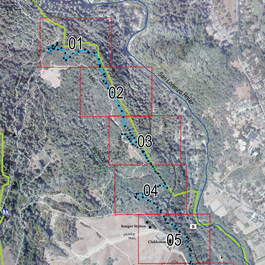home | metro santa cruz index | currents

RAIL TRAIL: The proposed Pogonip bike trail, in blue, would connect with the U-Con trail and run alongside the tracks.
Path to Peace
Can a multi-use trail solve an out-of-control drug problem?
By Curtis Cartier
SOCIAL SCIENTISTS call it the "Broken Window Theory." It's a concept that says cleaning up a blighted neighborhood's rundown appearance—its graffiti, its trash, its broken windows—jump-starts a virtuous cycle by making the neighborhood more appealing to law-abiding citizens: they move in, take pride in their surroundings and drive the criminals out. When Rudy Giuliani did it in New York City, it worked miracles. In Santa Cruz, where city leaders are looking into whether a new 1.5-mile-long bike, pedestrian and horse trail will bring enough residents through the drug and crime nexus of the Pogonip greenbelt to drive out its heroin and meth dealers, its effect seems less certain.
"What do we really know about how increasing bike use can affect crime?" asked Santa Cruz Councilmember Don Lane rhetorically at last week's city council meeting before voting to approve further investigation into the proposed path. "Do we really know that when we invite all these people up there that we are creating a safe place? Just look at the San Lorenzo River levee. That's a well-used path as well."
Few doubt the proposed path would benefit cyclists looking to ride the loop from the Rincon Connector and University Connector trails to Golf Club Drive. But many doubt whether the path can address a chronic drug problem. One of these is Joan Petersilia, co-director of the Stanford University Criminal Justice Center. She's spent 25 years analyzing law enforcement public policy efforts and says, in this case, Santa Cruz leaders may be pinning their hopes on a thin idea.
"This is called crime prevention through environmental design," says Petersilia. "However, in this case, it seems too simplistic. It's not that a (multi-use) path can't work, it just takes two or three more ingredients. First, increased lighting needs to be a huge aspect of the built environment. You also have to have foot traffic stops, so people stop along the path and convey the message that (the criminals) don't own the path, instead of just riding through. Third, you need law enforcement to make a huge initial presence for one to three years. After one to three years, studies show, law enforcement can reduce its presence as the community takes over."
Like many of the details of the proposed path, the cost of building it is unknown. City leaders have already earmarked $25,000 to draw up an environmental review, but they're reluctant to offer building cost estimates, as they're hoping to benefit from donated work hours from groups like the Mountain Bikers of Santa Cruz and the Santa Cruz County Horsemen's Association. But with annual costs in the park already high and the city in its worst financial straits in decades, it's unclear if the experiment would be worth it.
According to city financial documents and labor estimates by city employees, Santa Cruz spent $372,768 last year (a conservative estimate) to police and maintain the Pogonip—parts of which are closed to the public because of the crime problem itself.
The Santa Cruz Police Department alone spent an estimated $203,340 for its three-member Parks Unit to patrol the Pogonip last year. That's not counting the time nonofficers spent processing arrests and filing related paperwork. City rangers, who were instructed by Parks and Recreation staff not to speak with Santa Cruz Weekly for this article, estimated earlier this year that they spend between 30 and 50 percent of their time dealing with Pogonip-related issues, although estimates from parks administration put the figure at 25 percent. Assuming the actual amount is halfway between these estimates, the cost of ranger work in Pogonip is about $121,004 per year. Additionally, the Santa Cruz Fire Department responded to seven small fires in the greenbelt in 2009, according to Capt. Mark Ramos, who pegs this cost at $8,424. Finally, maintenance costs in the Pogonip—trail grading, sign posting and the much talked-about trash cleanups—are estimated to have run about $40,000 last year.
"I think the amount we spend in the Pogonip is disproportionately high," says newly minted Santa Cruz City Manager Martin Bernal. "You wouldn't normally expect to have the police Parks Unit spending half their time there given the amount of other open space we have." He adds, "I don't know if a trail will make any difference at all (in crime). What may make a difference is whether people use the trail."
Read a longer version of this article at www.santacruz.com. Find the top navigation bar and click on "News."/
Send letters to the editor here.
|
|
|
|
|
|